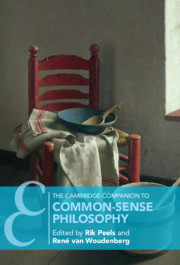Book contents
- The Cambridge Companion to Common-Sense Philosophy
- Other Volumes in the Series of Cambridge Companions
- The Cambridge Companion to Common-Sense Philosophy
- Copyright page
- Contents
- Contributors
- Introduction: Why Common Sense Matters
- Part I
- Part II
- 7 The Delineation of Common Sense
- 8 Common Sense in Metaphysics
- 9 Common-Sense Realism
- 10 The Epistemic Authority of Common Sense
- 11 Scepticism and Certainty: Moore and Wittgenstein on Common Sense and Philosophy
- 12 Morality and Common Sense
- 13 Common Sense and Ontological Commitment
- 14 The Tension between Scientific Knowledge and Common-Sense Philosophy
- 15 A Scientific-Realist Account of Common Sense
- References
- Index
- Other Volumes in the Series of Cambridge Companions
14 - The Tension between Scientific Knowledge and Common-Sense Philosophy
from Part II
Published online by Cambridge University Press: 06 November 2020
- The Cambridge Companion to Common-Sense Philosophy
- Other Volumes in the Series of Cambridge Companions
- The Cambridge Companion to Common-Sense Philosophy
- Copyright page
- Contents
- Contributors
- Introduction: Why Common Sense Matters
- Part I
- Part II
- 7 The Delineation of Common Sense
- 8 Common Sense in Metaphysics
- 9 Common-Sense Realism
- 10 The Epistemic Authority of Common Sense
- 11 Scepticism and Certainty: Moore and Wittgenstein on Common Sense and Philosophy
- 12 Morality and Common Sense
- 13 Common Sense and Ontological Commitment
- 14 The Tension between Scientific Knowledge and Common-Sense Philosophy
- 15 A Scientific-Realist Account of Common Sense
- References
- Index
- Other Volumes in the Series of Cambridge Companions
Summary
Contemporary philosophers often talk about the difference (and conflict) between the so-called manifest and scientific images of the world, a distinction famously introduced in 1962 by Wilfrid Sellars. Sellars favoured what he termed a ‘stereoscopic’ vision of the relationship between the two images, according to which a major task of philosophy is to articulate a view of the world that simultaneously takes account of the two perspectives. Sellars’s students soon divided into two camps. One group (e.g., Patricia and Paul Churchland, Ruth Millikan, Jay Rosenberg) has taken the position that whenever a conflict arises, the scientific image trumps the manifest one. A second group (e.g., Robert Brandom, John McDowell, Richard Rorty), by contrast, thinks that certain differences between the two images actually point to some of the limits of science, especially, but not only, when it comes to social categories and phenomena. This chapter explores two examples that encapsulate the debate between the so-called right and left wings of Sellarsian thought, suggesting a renewed research programme for philosophy in general, aiming at articulating the original stereoscopic vision that defines human understanding of the world as an integration of the two images – essentially, a confluence of common sense and scientific sense.
Keywords
- Type
- Chapter
- Information
- The Cambridge Companion to Common-Sense Philosophy , pp. 310 - 332Publisher: Cambridge University PressPrint publication year: 2020



